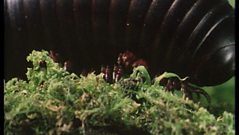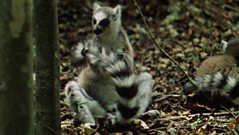
Wind power
Conifers were the first plants to spread their pollen via wind instead of water.
Conifers have the male and the female cone on the same tree.
The male cones use wind to transport their pollen, but to make sure they are successful they must produce pollen in huge quantities. One cone may therefore produce several million grains of pollen, and there are thousands of cones on an average tree.
The female cones are fewer in number and grow on the same branches. They are small globes in conspicuous branches, sitting on the tips of shoots where they have a good chance of receiving pollen.
When pollen falls on a female cone it is the beginning of a very long process as it takes a whole year for the pollen grains to grow down to the eggs and form a small green cone. Over the next year the cone grows and develops layers around the fertilized eggs.
It then dries out and opens up to release its seeds - the first kind of plant eggs to be fertilized without water transport.
Today, about a third of the world's forests are formed by conifers. Firs, larches, cedars and pines are all members of this group while the biggest organism of any kind is a conifer: the giant sequoia of California. It grows to 112 metres and may have a diameter of 12 metres.
Duration:
This clip is from
Featured in...
![]()
±«Óãtv Nature
Be captivated, informed and inspired by the world's wildlife.
More clips from The First Forests
-
![]()
Millennia of millipedes
Duration: 01:50
-
![]()
In their element
Duration: 01:34
More clips from Life on Earth
-
![]()
Lucky pups—The Rise of the Mammals
Duration: 03:29
-
![]()
Millennia of millipedes—The First Forests
Duration: 01:50
-
![]()
Creatures of the night—Life in the Trees
Duration: 01:16
-
![]()
Scent sense—Life in the Trees
Duration: 02:55







